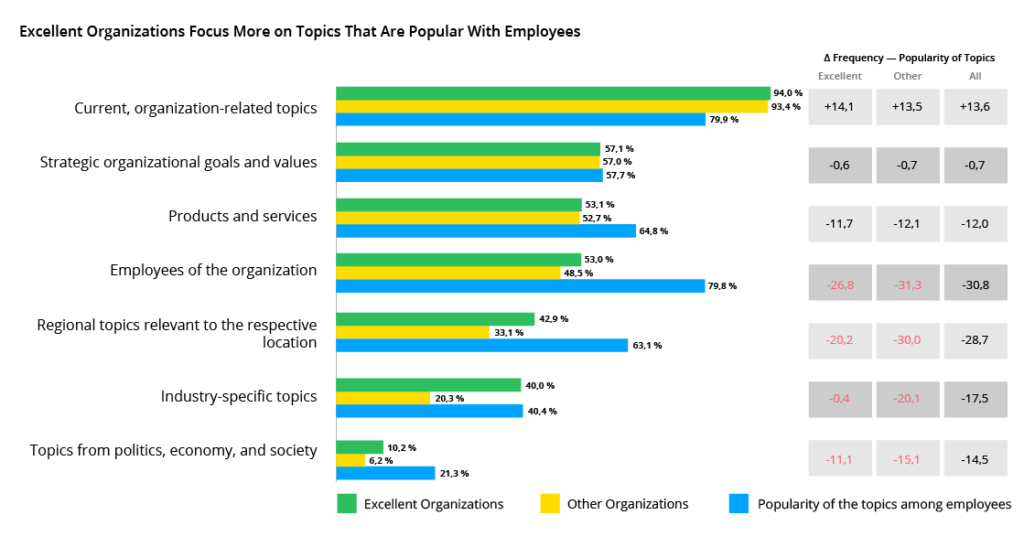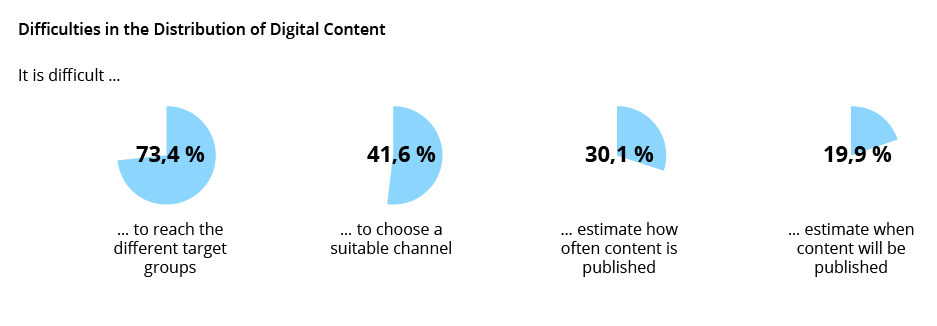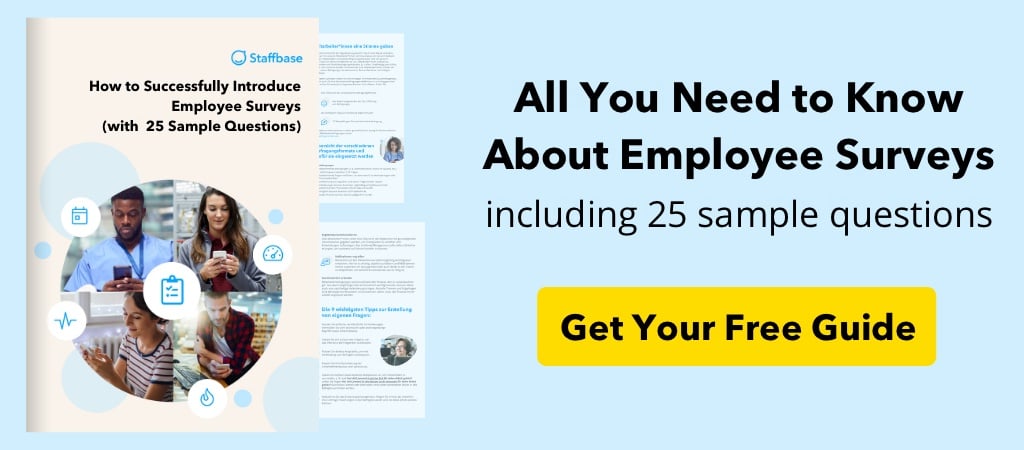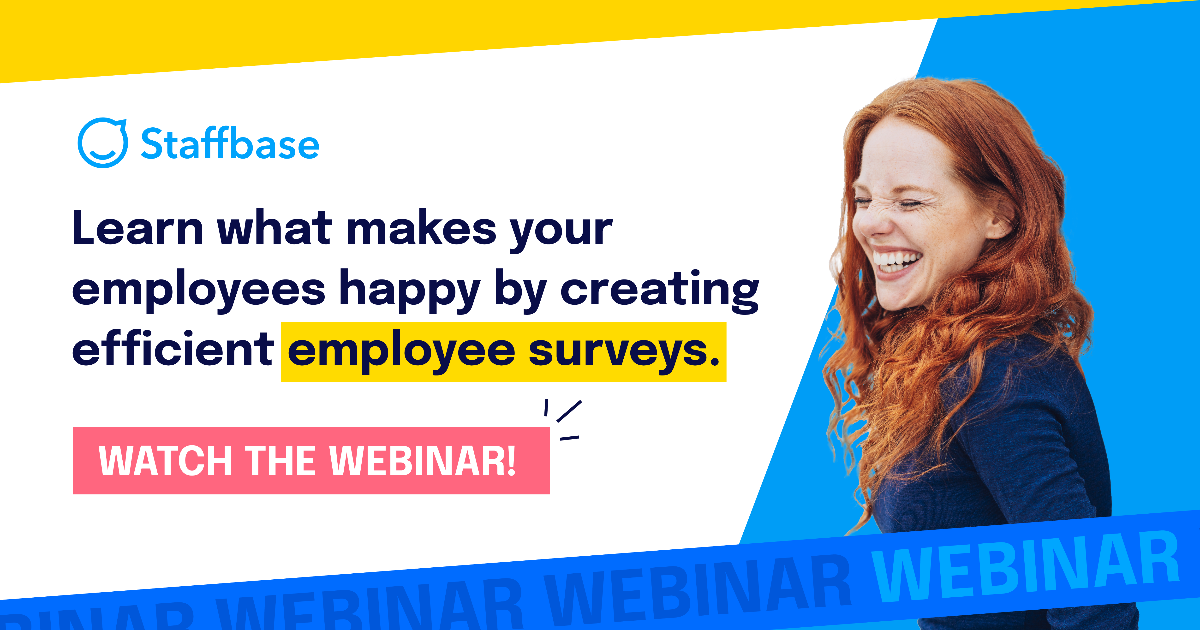Employee Surveys in Internal Communications: Guidelines, Tips, and Examples
Get a head start on your employee survey with our proven guidance, structure, and sample questions.

Do you want to get your employees more involved in decision-making and give them a voice in your organization? Great, because if so you’ll be right on trend. Employee surveys have long been an important topic, but these days they are crucial to the success of companies.
But where’s the best place to start? And what are the most important elements of a successful employee survey? You’ll find the answers to these questions right here. Not only have we summarized the most important types of employee surveys, but we’ve also created a guide for conducting them. And we’ve even collected some sample questions to get you started.
 Excellent organizations focus more on topics that are popular with employees.
Excellent organizations focus more on topics that are popular with employees.
Which format is right?
As seen above, there are different survey formats that have advantages and disadvantages depending on your goals. On the one hand, you should make sure that the survey type fits the set timeframe of your chosen objectives. On the other hand, you should determine whether only a mood barometer will help here or whether you’re trying to assess content-related topics.
Do you need answers to specific questions or will an open-ended survey be more useful? Do you want the survey to be short and concise or more detailed? If you see a concrete problem but have no solution, a collection of ideas can help instead of a survey. Here, too, goals and stakeholders determine the appropriate implementation.
The most important thing remains ease of use: To encourage employees to respond, the survey tool must remain accessible. This is especially true for colleagues far away from their desks. But the quality of answers may also depend on the right employee survey response scales.
How should results be communicated?
In order to ensure that continuous surveys do not come to nothing, but instead lead to effective results, you must also communicate them accordingly. Only by correctly handling processes and results can employees see and understand the changes that have been brought about.
You don’t have to present your employees with a perfect evaluation immediately after completing a survey. Often this isn’t even possible. For now, it’s enough to share an overview with basic information (e.g. general and past participation numbers) to spark interest and encourage motivation.
Results should be broken into departments and communicated to the respective team leads so they can respond accordingly. Putting data from different teams into a company-wide context helps to better identify problem areas. Likewise, recognize and share strengths and positive developments.

Creating a questionnaire: Sample questions for successful employee surveys
As indicated above, questions should vary depending on the objective and the company. Therefore, there is no universal sample solution for the choice of questions. Moreover, this remains dependent on the format of the survey chosen. However, there are some consistent topics, regardless of industry and company. These generally concern areas of employee satisfaction.
Leadership: Do you think that your leader gives you good instructions for your work?
Team: The last time you had difficulties with a task, did you ask a colleague for help?
Work/life balance: Can you manage both your job and your personal life?
Identification with the company: How likely is it that you would recommend your company as an employer to friends or acquaintances?
Communication: Do you feel sufficiently informed about changes in the company that affect you and your work?
Especially in the regular pulse survey, it helps to mix operational questions and meta-questions, i.e. those questions that relate to current issues in the company and those on the topic of recurring KPIs. In this way, you can create a balance when working out current and long-term topics. In addition, take care to strike the right tone. Surveys need wording with which your employees can identify. This can also vary from company to company.
Employee surveys and the works council
Depending on your country of employment, your organization may or may not have a works council. According to Wikipedia, a works council is “a shop-floor organization representing workers that functions as a local/firm-level complement to trade unions but is independent of these at least in some countries.”
Employees are the central stakeholder in the employee survey process. The goal of a survey is to give them a voice. The works council therefore plays an important role, especially when tackling deeper issues and problems. Involving the works council at an early stage and working together proactively helps to simplify the process of tackling measures and establishing a feedback culture. It also helps to establish trust, as many employees have always trusted the works council more than the management. It is advisable to clarify issues of data protection and functionality with the works council so that it can answer questions posed by employees on such topics.
Central to any employee survey: Data protection and anonymity
Data Privacy in Employee Surveys
You should not take the issue of data protection in employee surveys lightly. For any type of digital survey that includes a feedback system, data protection must be guaranteed. Especially those formats that allow for the processing of your employees’ data. Therefore, the first thing to check is whether a provider is DSGVO-compliant.
Since 2018, the EU General Data Protection Regulation specifies how data can be handled. These regulations relate in particular to data security, transparency, and procedural documentation. Despite these requirements, you should integrate the topic into the conception, the selection of the tool, and the process for surveys at an early stage. ISO 27001 certification can also tell you whether a provider has been trained to handle sensitive data and actually implements any data security standards.
You should be clear about the following questions:
Will data be stored for the purpose of conducting the surveys?
Is this data stored temporarily or permanently?
Where is the data located?
How will this data be processed?
Who has access to the results?
Anonymity in employee surveys
Whether anonymization is advisable or not also depends on the type of survey. In the case of a more in-depth opinion poll or a desired text feedback, it is important that employees know that answers will not reflect negatively on them. To allow participants to share concerns as well as openly address uncomfortable topics, you need to create a safe space. The option of an anonymous or confidential survey can help ease employees’ fears.
But even this functionality has its advantages and disadvantages. If the goal of a survey is to obtain a direct and above all honest opinion, it makes sense to go for anonymity (“true anonymity”). However, in a mood survey or when dealing with specific topics (e.g. concerning processes or products), open answers are helpful. Especially when generating ideas, it is advisable to suspend anonymity or to give the option to stand for the ideas with your own name.
True anonymity is often promised, but is rarely given. In most cases, providers of employee surveys do not use true anonymity, but rather confidentiality. Names and information of respondents are not displayed, but can theoretically be tracked.
Remain flexible: The employee survey is an ongoing process
In the end, however, no amount of planning can accommodate every change. Employee surveys always remain an agile process — especially over a long time frame. Current topics and follow-up questions are dependent on results obtained and answers given. Therefore, you need to constantly adjust to these and continuously adapt the process.
For now, your goal should be to motivate employees to respond, wait to see what happens, and ultimately adjust processes, results, and outcomes over time. Across all areas, sharing remains the most important thing. Especially in difficult times, it is advisable to share information, solicit feedback, and give employees a voice.
 Check out our webinar on pulse surveys with Sarah Manes:
Check out our webinar on pulse surveys with Sarah Manes:










